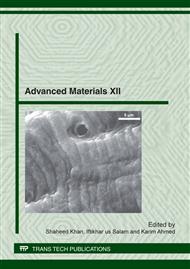[1]
G. Lianis, Stresses and strains in solid propellants during storage, ARS J. vol. 32 (1962), pp.688-692.
DOI: 10.2514/8.6125
Google Scholar
[2]
P. J. Blatz, W. L. Ko, and A. R. Zak, Fundamental studies relating to the mechanical behavior of solid propellants, rocket grains and rocket motors, Graduate Aeronautical Lab., California Institute of Technology SM62-63 (May 1962), pp.33-40.
Google Scholar
[3]
L. R. Herrmann and M. Tamekuni, Horizontal Slump of Solid Propellant Motors, AIAA J. vol. 3/4 (1965), pp.696-700.
DOI: 10.2514/3.2949
Google Scholar
[4]
U. E. Garrison, Grain Stress Analysis Study, AD Report No. AD-893602 (Feb 1972).
Google Scholar
[5]
J. E. Fitzgerald, Handbook for the Engineering Structural Analysis of Solid Propellants, University of Utah Lake City, Utah, (1971).
Google Scholar
[6]
R. A. Fiedler, M. S. Breitenfeld, X. Jiao, A. Haselbacher, P. Geubelle, D. Guoy, and M. Brandyberry, Simulations of Slumping Propellant and Flexing Inhibitors in Solid Rocket Motors, AIAA-2002-4341.
DOI: 10.2514/6.2002-4341
Google Scholar
[7]
A. Namazifard, K. Hjelmstad, P. Sofronis, K. Nakshatrala, D. Tortorelli, and R. Fiedler, Simulations of Propellant Slumping in the Titan IV SRMU Using Constitutive Models with Damage Evolution, 41st AIAA JPCE (2005), No. 2005-3994.
DOI: 10.2514/6.2005-3994
Google Scholar
[8]
K. Renganathan, B. Nageswara Rao, M. K. Jana, Slump Estimation of Cylindrical Segment Grains of a Typical Rocket Motor under Vertical Storage Condition, Trends in Appl. Sci. Res. vol. 1/1 (2006), pp.97-104.
DOI: 10.3923/tasr.2006.97.104
Google Scholar
[9]
G. P. Sutton and O. Biblarz, Rocket Propulsion Elements, 7th ed. Wiley & Sons USA, (2000).
Google Scholar
[10]
A. Davenas, Solid Rocket Propulsion Technology, (1993), Oxford, England, UK.
Google Scholar
[11]
D. J. Ferry, Viscoelastic properties of polymers, 3rd ed. John Wiley & sons USA, (1980).
Google Scholar
[12]
A. Mubashar, Modelling Degradation in Adhesive Joints Subjected to Fluctuating Service Conditions, PhD Thesis (2010), Loughborough University, UK.
Google Scholar
[13]
D. A. Dillard and A. V. Pocius, Adhesion Science and Engineering-I (The Mechanics of Adhesion), 1st ed. Elsevier Sci. B. V. (2002).
Google Scholar
[14]
J. G. Williams and A. Pavan, Fracture of Polymers, Composites and Adhesives, ESIS Publication No. 27, (2000).
Google Scholar
[15]
F. N. Kelley, Solid Propellant Mechanical Properties Testing, Failure Criteria and Ageing, Adv. in Chem. ACS publications (1969), pp.188-243.
Google Scholar
[16]
M. L. Williams, Structural Analysis of Viscoelastic Materials, AIAA J. (1963), pp.785-798.
Google Scholar
[17]
S. Y. Ho, Viscoelastic response of solid rocket motor components for service life assessment, J. Mat. Sci., vol. 32 (1997), pp.5155-5161.
Google Scholar
[18]
S. Cerri, M. A. Bohn, K. Menke and L. Galfetti, Ageing Behavior of HTPB Based Rocket Propellant Formulations, Cen. Euro. J. Ener. Mat., vol. 6/2 (2009), pp.149-165.
Google Scholar
[19]
N. J. Mills, Finite Element Models for the Viscoelasticity of Open-Cell Polyurethane Foam, Cellular Polymers, vol. 25/5 (2006).
DOI: 10.1177/026248930602500502
Google Scholar
[20]
K. W. Bills, D. M. Campbell, R. D. Steele and J. D. McConnell, Applications of Cumulative Damage in the Preparation of Parametric Grain Design Curves and the Prediction of Grain Failures on Pressurization, AD Report No. AD-710775 (Aug 1970).
Google Scholar
[21]
K. Renganathan, B. Nageswara Rao, M.K. Jana, An efficient axisymmetric hybrid-stress-displacement formulation for compressible/nearly incompressible material, International Journal of Pressure Vessels and Piping., 77 (2000), 651–667.
DOI: 10.1016/s0308-0161(00)00042-9
Google Scholar
[22]
S. Kilic, A. Karabeyoglu, J. Stevens and B. Cantwell, Modeling the Slump Characteristics of the Hydrocarbon-Based Hybrid Rocket Fuels, 39th AIAA/ASME/SAE/ASEE Joint Propulsion Conference and Exhibit 20-23 July 2003, Huntsville, Alabama, AIAA 2003-4461.
DOI: 10.2514/6.2003-4461
Google Scholar


